The prozone - Study guides, Class notes & Summaries
Looking for the best study guides, study notes and summaries about The prozone? On this page you'll find 99 study documents about The prozone.
Page 2 out of 99 results
Sort by
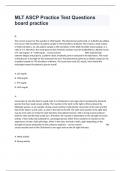
-
MLT ASCP Practice Test Questions board practice Exam With 100% Verified Answers Graded A+.
- Exam (elaborations) • 40 pages • 2024
- Available in package deal
-
- $15.99
- + learn more
B; The correct answer for this question is 1300 mg/dL. The laboratorian performed a 1:4 dilution by adding 0.25 mL (or 250 microliters) of patient sample to 750 microliters of diluent. This creates a total volume of 1000 microliters. So, the patient sample is 250 microliters of the 1000 microliter mixed sample, or a ratio of 1:4. Therefore, the result given by the chemistry analyzer must be multiplied by a dilution factor of 4. 325 mg/dL x 4 = 1300 mg/dL. - correct answer ...
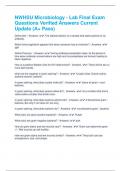
-
NWHSU Microbiology - Lab Final Exam Questions Verified Answers Current Update (A+ Pass)
- Exam (elaborations) • 6 pages • 2024
- Available in package deal
-
- $12.99
- + learn more
NWHSU Microbiology - Lab Final Exam Questions Verified Answers Current Update (A+ Pass) Define titer - Answers - The highest dilution of a sample that tests positive for an antibody. Which immunoglobulin appears first when someone has an infection? - Answers - IgM Define Prozone. - Answers - During antibody precipitation tests, its the period of time when antibody concentrations are high and no precipitates are formed, leading to false negatives. How is a positive Western blot for HI...
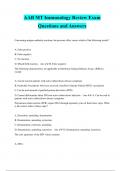
-
AAB MT Immunology Review Exam Questions and Answers
- Exam (elaborations) • 12 pages • 2023
- Available in package deal
-
- $12.49
- + learn more
AAB MT Immunology Review Exam Questions and Answers Concerning antigen-antibody reactions, the prozone effect causes which of the following results? A. False positive B. False negative C. No reaction D. Mixed field reaction - Ans ️️ -B. False negative The following characteristics are applicable to Interferon-Gamma Release Assays (IGRAs) except: A. Can be used in patients with active tuberculosis disease symptoms B. Preferable for patients who have received a bacillus Calmette-Gué...
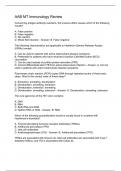
-
AAB MT Immunology Review
- Exam (elaborations) • 9 pages • 2023
-
- $11.49
- + learn more
Concerning antigen-antibody reactions, the prozone effect causes which of the following results? A. False positive B. False negative C. No reaction D. Mixed field reaction - Answer- B. False negative The following characteristics are applicable to Interferon-Gamma Release Assays (IGRAs) except: A. Can be used in patients with active tuberculosis disease symptoms B. Preferable for patients who have received a bacillus Calmette-Guérin (BCG) vaccination C. Can be used instead of puri...
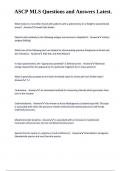
-
ASCP MLS Questions and Answers Latest.
- Exam (elaborations) • 20 pages • 2023
-
- $12.99
- + learn more
ASCP MLS Questions and Answers Latest. What feature is most often found with patients with a splenectomy on a Wright's stained blood smear? Answer Howell-Jolly bodies Patients with antibody to the following antigen are immune to Hepatitis B: Answer Surface antigen (HbSAg) Which two of the following tests are helpful for documenting previous Streptococcal throat and skin infections: Answer ASO titer and Anti-DNase B In mass spectrometry, the "appearance potential" is defined as the: Ans...
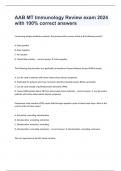
-
AAB MT Immunology Review exam 2024 with 100% correct answers
- Exam (elaborations) • 13 pages • 2024
-
- $15.49
- + learn more
Concerning antigen-antibody reactions, the prozone effect causes which of the following results? A. False positive B. False negative C. No reaction D. Mixed field reaction - correct answer B. False negative The following characteristics are applicable to Interferon-Gamma Release Assays (IGRAs) except: A. Can be used in patients with active tuberculosis disease symptoms B. Preferable for patients who have received a bacillus Calmette-Guérin (BCG) vaccination C. Can be used instea...
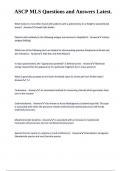
-
ASCP MLS Questions and Answers Latest.
- Exam (elaborations) • 20 pages • 2023
-
- $12.99
- + learn more
ASCP MLS Questions and Answers Latest. What feature is most often found with patients with a splenectomy on a Wright's stained blood smear? Answer Howell-Jolly bodies Patients with antibody to the following antigen are immune to Hepatitis B: Answer Surface antigen (HbSAg) Which two of the following tests are helpful for documenting previous Streptococcal throat and skin infections: Answer ASO titer and Anti-DNase B In mass spectrometry, the "appearance potential" is defined as the: Ans...
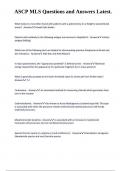
-
ASCP MLS Questions and Answers Latest.
- Exam (elaborations) • 20 pages • 2023
-
- $12.99
- + learn more
ASCP MLS Questions and Answers Latest. What feature is most often found with patients with a splenectomy on a Wright's stained blood smear? Answer Howell-Jolly bodies Patients with antibody to the following antigen are immune to Hepatitis B: Answer Surface antigen (HbSAg) Which two of the following tests are helpful for documenting previous Streptococcal throat and skin infections: Answer ASO titer and Anti-DNase B In mass spectrometry, the "appearance potential" is defined as the: Ans...
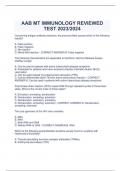
-
AAB MT IMMUNOLOGY REVIEWED TEST 2023/2024
- Exam (elaborations) • 9 pages • 2023
- Available in package deal
-
- $11.49
- + learn more
AAB MT IMMUNOLOGY REVIEWED TEST 2023/2024 Concerning antigen-antibody reactions, the prozone effect causes which of the following results? A. False positive B. False negative C. No reaction D. Mixed field reaction - CORRECT ANSWER-B. False negative The following characteristics are applicable to Interferon-Gamma Release Assays (IGRAs) except: A. Can be used in patients with active tuberculosis disease symptoms B. Preferable for patients who have received a bacillus Calmette-Guérin...
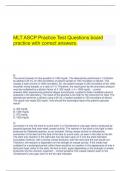
-
MLT ASCP Practice Test Questions board practice with correct answers.
- Exam (elaborations) • 25 pages • 2023
- Available in package deal
-
- $11.49
- + learn more
MLT ASCP Practice Test Questions board practice with correct answers. B; The correct answer for this question is 1300 mg/dL. The laboratorian performed a 1:4 dilution by adding 0.25 mL (or 250 microliters) of patient sample to 750 microliters of diluent. This creates a total volume of 1000 microliters. So, the patient sample is 250 microliters of the 1000 microliter mixed sample, or a ratio of 1:4. Therefore, the result given by the chemistry analyzer must be multiplied by ...

That summary you just bought made someone very happy. Also get paid weekly? Sell your study resources on Stuvia! Discover all about earning on Stuvia


